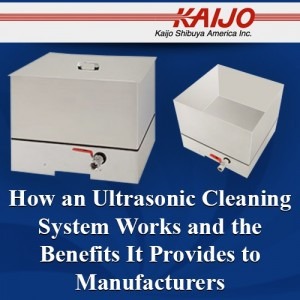How an Ultrasonic Cleaning System Works and the Benefits It Provides to Manufacturers
May 19, 2016
 Small and mid-size businesses and manufacturers can use an ultrasonic cleaning system to help improve their productivity. Such systems can remove contaminants and surface matter from components and can clean products before they are offered for sale. They will clean items such as machined parts, glass, ceramics and medical devices quickly and completely without using harsh chemicals. Businesses that have to clean products and manufacturers that require cleaning as part of their production can benefit from the gentle but effective cleaning action provided by ultrasonic cleaners such as Kaijo’s Phenix III TurnKey Ultrasonic Cleaning System.
Small and mid-size businesses and manufacturers can use an ultrasonic cleaning system to help improve their productivity. Such systems can remove contaminants and surface matter from components and can clean products before they are offered for sale. They will clean items such as machined parts, glass, ceramics and medical devices quickly and completely without using harsh chemicals. Businesses that have to clean products and manufacturers that require cleaning as part of their production can benefit from the gentle but effective cleaning action provided by ultrasonic cleaners such as Kaijo’s Phenix III TurnKey Ultrasonic Cleaning System.
How Ultrasonic Cleaning Systems Work
A turnkey ultrasonic cleaning system is made up of a generator, one or more transducers and a tank. The ultrasonic generator produces an electric signal at different frequencies and powers to actuate the transducers. The ultrasonic transducers convert the electrical signal into ultrasonic waves in the water within the tank. The water may have cleaning solutions added to improve the effectiveness of the ultrasonic cleaning process, depending on the nature of the contaminant to be removed.
When the ultrasonic transducers produce compression waves in the water, cavitation bubbles form in the liquid between the compression peaks. When a compression peak passes over the bubbles, they collapse and then form again after the peak travels on. This formation and collapsing of bubbles in the liquid in contact with the item to be cleaned results in a strong scrubbing action. The collapse of the bubbles is especially energetic and the bubbles remove any foreign material adhering to the surface to be cleaned.
Kaijo’s Turn Key System
Kaijo’s Phenix III Ultrasonic Cleaning System operates at 26 kHz or 38 kHz and delivers up to 1200 W of cleaning power. The two frequencies are ideal for general purpose cleaning, with the lower frequency providing robust cleaning with larger bubbles generated by the system and the higher frequency delivering gentler cleaning with smaller bubbles. The system comes as the Phenix III ultrasonic generator and a stainless steel tank with the transducers already installed. The system is easy to connect and can go into service right away.
The cost-effective Phenix ultrasonic generator is available in four models with outputs at the two frequencies and at 600 W or 1200 W. The output is adjustable in ten steps and the unit can be connected to 200 V to 240 V, 50/60 Hz (selectable). The compact unit weighs only 22 lbs. and can be operated from and external controller using the remote terminal.
The cleaning tank is available in sizes from about one cubic foot to the largest tank measuring about 4.5 cubit feet. The tank is made from one-eight inch thick gloss polished stainless steel for excellent ultrasonic cleaning performance. A Kaijo Water Resonance System to condition the water for superior ultrasonic cleaning can be added. The water resonance system increases the sound pressure and improves the cleaning action of the bubbles.
Kaijo ultrasonic cleaning systems are designed for low noise and no erosion of the parts and components to be cleaned. The tanks and transducer can withstand up to 100 degrees C for hot bath cleaning. For specific cleaning solutions, lower and higher frequency systems are also available.
Ultrasonic Cleaning System Benefits
Ultrasonic cleaning is often the lowest cost, quickest and most effective solution available to small and mid-sized businesses and manufacturing plants. Avoiding the cost of aggressive chemicals and of their neutralization and disposal can be a major cost factor. The systems can work very quickly, depending on the material to be removed. Light cleaning can be completed in a few minutes and the removal of heavier deposits often takes less than 15 or 20 minutes. The cleaning action of the tiny bubbles penetrates cavities and cleans irregular surfaces completely.
Ultrasonic technology is applicable to a wide variety of materials and can help make plant and business operations more productive while saving money. They represent an excellent investment for small and mid-sized operations seeking to improve their bottom line.





